苏教版初一英语语法总结
苏教版初一上册英语知识点汇总

苏教版初一上册英语知识点汇总Unit 1 This is me一、基础词汇与日常用语1.问候与告别•Good morning / afternoon / evening! 早上好/下午好/晚上好!•Good night! 晚安!•Hello! / Hi! 你好!•See you! / See you later! / See you next time! 再见!/下次见!•Good-bye! / Bye! 再见!2.认识与介绍•Nice / Glad to meet you! 认识你很高兴!•Nice / Glad to see you! 见到你很高兴!•This is ... 这位是……•My name is ... 我叫……•I’m ... 我是……•What’s your name? 你叫什么名字?3.欢迎与感谢•Welcome to ... 欢迎来到……•Thank you! / Thanks! 谢谢!•You’re welcome! / That’s OK! / That’s all right! 不用谢!4.询问与回答•How do you do? 你好!•How are you? 你好吗?•Fine, thank you. And you? 很好,谢谢。
你呢?•I’m OK / I’m fine, too. 我也很好。
•Are you ...? 你是……吗?•Yes, I am. / No, I’m not. 是的,我是。
/ 不,我不是。
5.年龄与班级•... years old ...岁•What grade are you in? 你在几年级?•I am in Grade Seven. 我在七年级。
•What class are you in? 你在几班?•I am in Class Five. 我在五班。
6.联系方式•telephone number 电话号码•QQ number QQ号码•What’s your telephone number? 你的电话号码是多少?•My telephone number is ... / It’s ... 我的电话号码是……二、重点句型和语法1.be动词用法•我(I)用am,你(you)用are,is跟着他(he)、她(she)、它(it)。
苏教版初一下册英语知识点汇总

苏教版初一下册英语知识点汇总一、名词所有格在英语中,名词所有格用于表示名词之间的所属关系。
主要有两种形式:1.'s所有格:•单数名词和不以s结尾的复数名词在词尾加's。
例如:Kangkang's books(康康的书)。
•以s结尾的复数名词在词尾直接加'。
例如:Tom and Helen's desk(汤姆和海伦的桌子)。
•如果两个名词并列,且分别表示各自的所有关系,则两个名词后都要加's。
例如:Ann's and Maria's bikes(安和玛丽亚的自行车)。
2.of所有格:•使用of表示“……的”,通常用于无生命物体的所属关系。
例如:a book of mine(我的一本书)。
•of所有格的结构为“名词+of+名词”,翻译时要从of后往前翻译。
二、动词的用法及区别1.have与of的区别:•have一般表示“主动拥有”,通常用于有生命的人或动物。
例如:I have a new bike.(我有一辆新自行车。
)•无生命的物体一般不能“主动拥有”,表示所属关系时要用of。
例如:a door of the house(房子的一扇门)。
2.speak与say的区别:•speak表示“说”的动作,不表示说的内容。
例如:She speaks English.(她说英语。
)•say表示“说”的内容。
例如:He says he is tired.(他说他累了。
)•speak后面除了能接“语言”外,不能直接接东西,后面加了to则表示“对……说”。
3.want to do sth.与would like to do sth.:•两者都表示“想要做某事”,可以互换使用。
例如:I want to go shopping.(我想要去购物。
)/ I would like to go shopping.(我想要去购物。
)4.both与all的区别:•both表示“两者都……”。
初中英语苏教版知识点总结
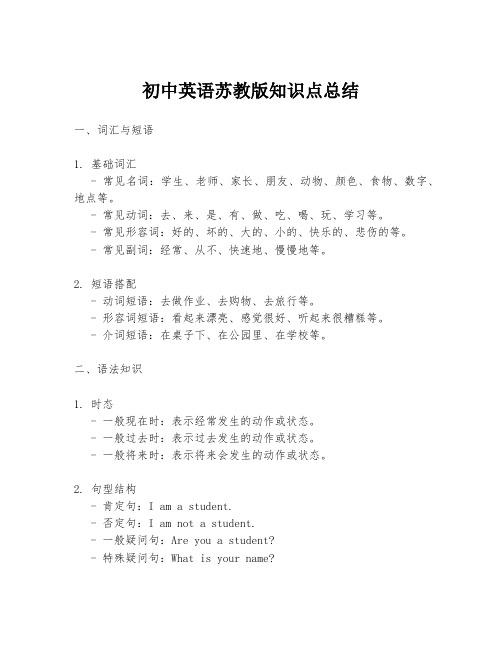
初中英语苏教版知识点总结一、词汇与短语1. 基础词汇- 常见名词:学生、老师、家长、朋友、动物、颜色、食物、数字、地点等。
- 常见动词:去、来、是、有、做、吃、喝、玩、学习等。
- 常见形容词:好的、坏的、大的、小的、快乐的、悲伤的等。
- 常见副词:经常、从不、快速地、慢慢地等。
2. 短语搭配- 动词短语:去做作业、去购物、去旅行等。
- 形容词短语:看起来漂亮、感觉很好、听起来很糟糕等。
- 介词短语:在桌子下、在公园里、在学校等。
二、语法知识1. 时态- 一般现在时:表示经常发生的动作或状态。
- 一般过去时:表示过去发生的动作或状态。
- 一般将来时:表示将来会发生的动作或状态。
2. 句型结构- 肯定句:I am a student.- 否定句:I am not a student.- 一般疑问句:Are you a student?- 特殊疑问句:What is your name?3. 代词- 人称代词:I, you, he, she, it, we, they.- 物主代词:my, your, his, her, its, our, their.- 反身代词:myself, yourself, himself, herself, itself, ourselves, yourselves, themselves.4. 冠词- 不定冠词:a, an.- 定冠词:the.5. 介词- 表示时间:at, on, in.- 表示地点:at, on, in, under, above, behind.- 表示方向:to, towards, through.6. 连词- 并列连词:and, but, or, so.- 从属连词:because, since, although, if, when, while.三、阅读理解1. 文章类型- 记叙文:讲述人物、事件的故事。
- 说明文:解释事物的特性、原因、过程等。
初中英语语法(苏教版)教材语法目录
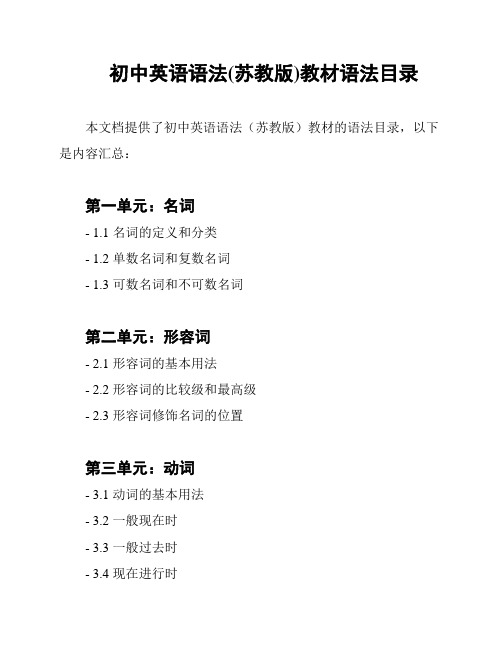
初中英语语法(苏教版)教材语法目录
本文档提供了初中英语语法(苏教版)教材的语法目录,以下是内容汇总:
第一单元:名词
- 1.1 名词的定义和分类
- 1.2 单数名词和复数名词
- 1.3 可数名词和不可数名词
第二单元:形容词
- 2.1 形容词的基本用法
- 2.2 形容词的比较级和最高级
- 2.3 形容词修饰名词的位置
第三单元:动词
- 3.1 动词的基本用法
- 3.2 一般现在时
- 3.3 一般过去时
- 3.4 现在进行时
- 3.5 一般将来时
第四单元:副词
- 4.1 副词的基本用法
- 4.2 表示时间的副词
- 4.3 表示地点的副词
- 4.4 表示方式的副词
第五单元:代词
- 5.1 人称代词的基本用法- 5.2 物主代词的基本用法- 5.3 反身代词的基本用法
第六单元:介词
- 6.1 介词的基本用法
- 6.2 表示位置的介词
- 6.3 表示时间的介词
- 6.4 表示方式的介词
第七单元:连词
- 7.1 连词的基本用法
- 7.2 并列连词
- 7.3 选择连词
- 7.4 原因连词
第八单元:句子结构
- 8.1 简单句的基本结构
- 8.2 并列句的结构
- 8.3 复合句的结构
以上是初中英语语法(苏教版)教材的部分语法目录。
这些内容将帮助学习者掌握基本的英语语法知识,为之后的学习打下坚实的基础。
江苏初一英语重点知识点归纳总结

江苏初一英语重点知识点归纳总结英语是一门重要的语言,也是我们学习的必修科目之一。
初中一年级的英语学习,是打下英语基础知识的关键时期。
为了帮助同学们更好地掌握初一英语的重点知识点,下面对江苏初一英语的重点知识进行归纳总结。
一、基础语法知识点1. 词汇:学会识别和记忆一些常用的基础词汇,例如人称代词、动词、名词、形容词、副词等,这些词汇是构建句子的基础。
2. 时态:了解和掌握一些常用的时态,例如一般现在时、一般过去时、一般将来时等,这些时态可以帮助我们正确地表达不同时间的事情。
3. 句型:熟悉和掌握一些常用的基础句型,例如陈述句、疑问句、否定句,以及条件句、比较句和祈使句等。
句型的掌握能够帮助我们用更多样的方式进行表达。
二、听力技巧1. 听力材料:学会仔细阅读题目,在听力开始前先预读听力材料,了解大概内容,这有助于提高听力理解能力。
2. 注意力集中:在听力过程中,保持注意力集中,注意听清每个单词、短语和句子,要特别注意特殊的发音和重要信息的表达。
3. 笔记技巧:尽量用简洁的方式做笔记,以便能同时听和写,记录下重点信息和关键词,以便后续的听写和理解。
三、阅读技巧1. 阅读材料:在阅读之前,先大致浏览一下全文,了解文章主题和大意,有助于我们更好地抓住文章关键信息。
2. 预测猜测:在阅读过程中,根据已知的信息和上下文的线索,尝试预测答案,帮助我们更好地理解文章。
3. 注意细节:注意抓住细节信息,例如数字、时间、地点等,这些细节信息通常与问题的回答息息相关。
四、写作技巧1. 句子结构:学会使用多样的句子结构,例如简单句、并列句、复合句等,以及连接词的正确使用,这样可以使我们的句子更加丰富有趣。
2. 文章结构:写作时应注意文章的结构,包括引言、主体段落和结论,清晰地表达我们的观点和理由。
3. 词汇运用:运用适当的词汇丰富我们的文章,同时注意词汇的拼写和用法的正确性。
总之,江苏初一英语的重点知识点可以归纳为基础语法知识点、听力技巧、阅读技巧和写作技巧等。
初中英语知识点总结归纳苏教版

初中英语知识点总结归纳苏教版一、词汇与短语1. 基础词汇- 常见名词:家庭成员、学校科目、日常用品、颜色、数字、天气等。
- 动词:基本动作、感官动词、情态动词等。
- 形容词:描述人物特征、物品属性、情感状态等。
- 副词:频率副词、程度副词、时间地点副词等。
2. 短语搭配- 动词短语:look at, listen to, help with等。
- 介词短语:in the morning, on the desk, by the way等。
- 常见句型:be good at, have to, would like to等。
二、语法结构1. 时态- 一般现在时:表示经常发生的动作或状态。
- 一般过去时:表示过去某一确定时间发生的动作。
- 现在进行时:表示正在进行的动作或状态。
- 过去进行时:表示过去某一时刻正在进行的动作。
2. 语态- 被动语态:表示主语是动作的承受者。
- 一般现在时被动语态:am/is/are + past participle。
- 一般过去时被动语态:was/were + past participle。
3. 非谓语动词- 动名词:作为名词使用,表示动作,如swimming, reading。
- 分词:现在分词和过去分词,用作形容词或副词。
- 动词不定式:to + base form of verb,用作主语、宾语、表语等。
4. 代词- 人称代词:主格和宾格。
- 物主代词:形容词性物主代词和名词性物主代词。
- 反身代词、指示代词、疑问代词等。
5. 介词- 表示时间、地点、方向、原因、方式等。
- 常见介词:at, in, on, for, with, by, to, from等。
6. 连词- 并列连词:and, but, or, so等,连接并列句。
- 从属连词:because, since, although, if, when等,引导从句。
7. 句子结构- 简单句:一个主语和一个谓语构成的句子。
苏教版七年级上册英语知识点汇总

苏教版七年级上册英语知识点汇总一、词汇与短语1.基础词汇:学习并掌握日常生活、学校生活、家庭成员、颜色、数字、时间、日期等基础词汇。
2.短语与习惯用语:积累常见的问候语、自我介绍、告别语、感谢与道歉的表达方式,以及描述物品、人物特征、日常活动等的基本短语。
二、语法知识1.be动词:掌握be动词(am, is, are)的基本用法,用于描述主语的状态或特征。
2.一般现在时:学习一般现在时的基本结构和用法,特别是主语为第三人称单数时动词的变化规则。
3.名词:了解可数名词与不可数名词的区别,掌握名词复数的规则变化和不规则变化。
4.冠词:学习定冠词the和不定冠词a/an的基本用法,理解其在句子中的位置和作用。
5.代词:掌握人称代词(主格、宾格)、物主代词(形容词性、名词性)的基本用法,以及反身代词、指示代词、疑问代词的初步认识。
6.介词:学习常见介词的基本用法,如表示时间、地点、方位的介词。
7.形容词与副词:初步了解形容词用于描述名词,副词用于修饰动词、形容词或其他副词的基本用法。
三、听力与口语1.日常对话:通过模拟日常生活场景,如打招呼、介绍自己与他人、询问个人信息等,提高听力理解和口语表达能力。
2.语音语调:注重发音的准确性,包括元音、辅音的发音,以及单词重音、句子语调的训练,使口语表达更加自然流畅。
3.听力材料:利用课本配套的听力练习、英语歌曲、简短视频等,提高学生的听力理解能力,培养语感。
四、阅读与写作1.阅读技能:培养快速阅读、寻找关键信息、理解文章大意等基本技能,通过阅读简单的短文、对话等,提高阅读理解能力。
2.阅读材料:涵盖日常生活、学校生活、节日庆典、兴趣爱好等多个话题,丰富学生的语言输入。
3.写作技巧:学习基本的写作格式和技巧,如书写规范、标点符号的使用、简单句和并列句的写作等。
通过仿写、改写等练习,逐步提高学生的写作能力。
4.创意写作:鼓励学生发挥想象力,进行简单的创意写作,如编写小故事、描述图片内容等,培养学生的写作兴趣和创造力。
(word完整版)初一英语语法(苏教版)

现在完成时中“since”和“for”的区别1)since +过去一个时间点(如具体的年、月、日期、钟点、1980,last month,half past six)。
I have been here since 1989.2)since +一段时间+ agoI have been here since five months ago.3)since +从句Great changes have taken place since you left.Considerable time has elapsed since we have been here.4)It is +一段时间+ since从句It is two years since I became a postgraduate student.Since 用来说明动作起始时间,for用来说明动作延续时间长度。
I have lived here for more than twenty years.I have lived here since I was born..My aunt has worked in a clinic since 1949.Some new oilfields have been opened up since 1976.I have known Xiao Li since she was a little girl.My brother has been in the Youth League for two years.I have not heard from my uncle for a long time.注意:并非有for 作为时间状语的句子都用现在完成时。
I worked here for more than twenty years.(我现在已不在这里工作。
)I have worked here for many years.(现在我仍在这里工作。
(完整版)苏教版初中英语语法

苏教版初中英语语法(2012—10-05 10:03:32)转载▼标签:杂谈中考复习系列一词汇一、中考对词汇的考查主要集中在以下几个方面:1、能正确拼写大纲词汇表中的常用单词;2、掌握大纲词汇表中所列全部单词的词文,并了解其词类(词性);3、了解构词法的基本知识,并根据此知识判断常用词的合成词与派生词的词义和词类,例如:drive –driver, use – useful;4、正确理解现行教材课文中出现过的短语与习语;正确使用及辨析其中比较常见的短语和习语;5、理解词类转化,例如:water (n.) – water (v。
)二、词汇考查点分项说明:1、掌握大纲词汇表,了解词类1)大纲词汇表中所列的词汇基本上为1至6册课本中所列的四会单词(即书后单词表中不带任何符号的单词)。
要求同学们把所列单词的词义完全掌握。
在此基础上,了解其词类(词性).尤其注意要在情景中运用该词,而不是孤立地去记忆某个单词。
2)针对大纲词汇表中的常用单词,一定要能做到正确拼写。
该项知识常以单词拼写的形式来考查学生,但一般无难题,基本属于送分题。
出题范围主要是大纲中的一、二级词汇,也有可能出现非大纲词汇,但一般为常用词汇,尽管不在大纲中出现,却通常在课文中出现过。
请看以下几道例题:1。
Shanghai is a large c t in China。
2。
Adam often helps me a lot。
He is my best f nd。
3。
I can’t carry the box。
It's too h v .4。
The man is very poor. He had no m n to buy food。
5。
---How often do you play football?—-— Tw a week.6. My grandparents like growing flowers。
They w t the flowers everyday。
苏教版初一教材中的重点语法解析
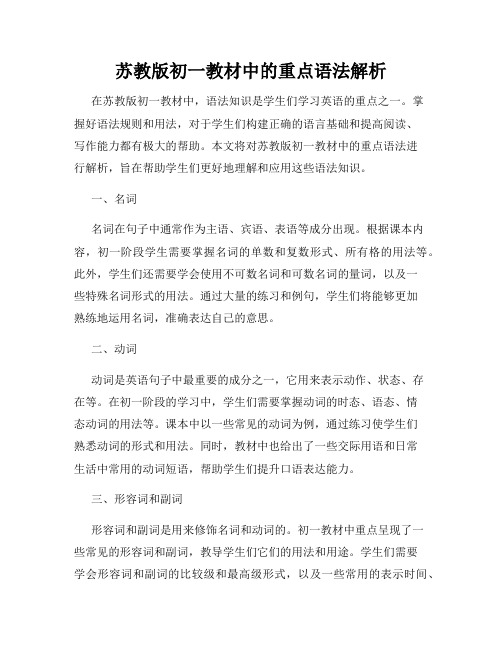
苏教版初一教材中的重点语法解析在苏教版初一教材中,语法知识是学生们学习英语的重点之一。
掌握好语法规则和用法,对于学生们构建正确的语言基础和提高阅读、写作能力都有极大的帮助。
本文将对苏教版初一教材中的重点语法进行解析,旨在帮助学生们更好地理解和应用这些语法知识。
一、名词名词在句子中通常作为主语、宾语、表语等成分出现。
根据课本内容,初一阶段学生需要掌握名词的单数和复数形式、所有格的用法等。
此外,学生们还需要学会使用不可数名词和可数名词的量词,以及一些特殊名词形式的用法。
通过大量的练习和例句,学生们将能够更加熟练地运用名词,准确表达自己的意思。
二、动词动词是英语句子中最重要的成分之一,它用来表示动作、状态、存在等。
在初一阶段的学习中,学生们需要掌握动词的时态、语态、情态动词的用法等。
课本中以一些常见的动词为例,通过练习使学生们熟悉动词的形式和用法。
同时,教材中也给出了一些交际用语和日常生活中常用的动词短语,帮助学生们提升口语表达能力。
三、形容词和副词形容词和副词是用来修饰名词和动词的。
初一教材中重点呈现了一些常见的形容词和副词,教导学生们它们的用法和用途。
学生们需要学会形容词和副词的比较级和最高级形式,以及一些常用的表示时间、程度、方式等副词。
通过不断的练习,学生们能够更准确地描述事物和表达自己的感受。
四、代词代词在句子中代替名词,避免重复出现。
初一教材中介绍了人称代词、物主代词、指示代词、不定代词等的用法。
学生们需要学会区分主格、宾格、所有格等不同情况下代词的使用,并且能正确运用它们进行口语和书面表达。
五、介词介词在句子中用来表示方位、时间、原因等关系。
初一阶段的学习中,学生们需要学会一些常用的介词,如in、on、at、with、of等,并了解它们在句子中的正确用法。
通过介词的学习,学生们能够更准确地描述事物的关系和位置。
六、连词连词用来连接句子或词组,起到衔接句子之间,使语言更连贯流畅的作用。
在初一教材中,学生们通过学习一些常用的并列连词和从属连词,如and、but、or、because、if等,掌握它们的用法和应用场景。
七年级英语苏教版知识点

七年级英语苏教版知识点七年级英语是初中学习的重要阶段,而苏教版则是国内较为常见的教材之一。
在学习七年级英语苏教版的过程中,我们需要掌握以下知识点:一、基础语法知识1. 时态在英语语法中,时态是重要的基础知识点。
七年级英语中,我们需要学习的时态包括一般现在时、一般过去时和一般将来时等。
例如:I usually go to school by bike.(我通常骑自行车上学。
)Yesterday, I watched a movie with my friends.(昨天我和朋友们一起看了一部电影。
)I will visit my grandparents next weekend.(下个周末我会去拜访我的祖父母。
)2. 词性词性也是七年级英语的基础知识点之一。
我们需要学习名词(包括可数名词和不可数名词)、代词、动词、形容词、副词等词性,并了解它们的基本用法。
例如:Noun(名词):book(书)、desk(书桌)、water(水)Pronoun(代词):I(我)、he(他)、she(她)Verb(动词):go(去)、eat(吃)、play(玩)Adjective(形容词):big(大的)、red(红的)、happy(高兴的)Adverb(副词):slowly(缓慢地)、quietly(安静地)、happily(快乐地)二、日常口语学习英语不仅要掌握基础语法知识,还要了解基本的日常口语表达。
在七年级英语苏教版中,我们需要学习如何用英语进行问候、介绍、问路等基本日常场景。
例如:Greeting(问候):Hi! How are you?(你好!你怎么样?)Introducing(介绍):This is my friend, Mike.(这是我的朋友迈克。
)Asking for directions(问路):Excuse me, where is the nearest post office?(请问,最近的邮局在哪里?)三、阅读技巧阅读对于学习英语是非常重要的,通过阅读我们可以掌握知识并提高语感。
苏教版七年级下册英语知识点汇总
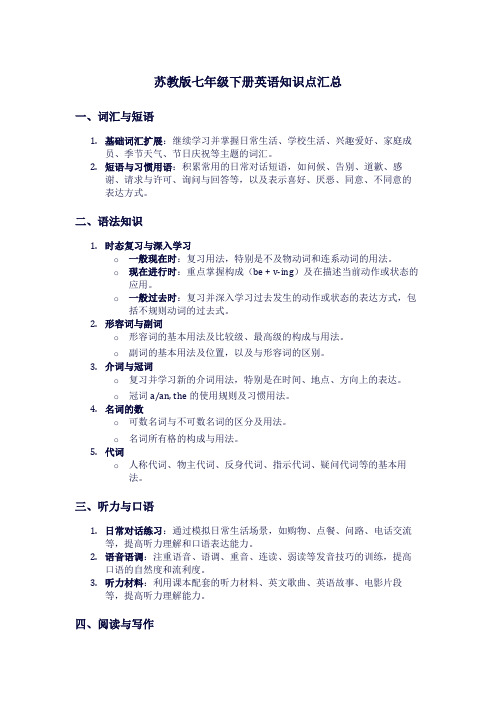
苏教版七年级下册英语知识点汇总一、词汇与短语1.基础词汇扩展:继续学习并掌握日常生活、学校生活、兴趣爱好、家庭成员、季节天气、节日庆祝等主题的词汇。
2.短语与习惯用语:积累常用的日常对话短语,如问候、告别、道歉、感谢、请求与许可、询问与回答等,以及表示喜好、厌恶、同意、不同意的表达方式。
二、语法知识1.时态复习与深入学习o一般现在时:复习用法,特别是不及物动词和连系动词的用法。
o现在进行时:重点掌握构成(be + v-ing)及在描述当前动作或状态的应用。
o一般过去时:复习并深入学习过去发生的动作或状态的表达方式,包括不规则动词的过去式。
2.形容词与副词o形容词的基本用法及比较级、最高级的构成与用法。
o副词的基本用法及位置,以及与形容词的区别。
3.介词与冠词o复习并学习新的介词用法,特别是在时间、地点、方向上的表达。
o冠词a/an, the的使用规则及习惯用法。
4.名词的数o可数名词与不可数名词的区分及用法。
o名词所有格的构成与用法。
5.代词o人称代词、物主代词、反身代词、指示代词、疑问代词等的基本用法。
三、听力与口语1.日常对话练习:通过模拟日常生活场景,如购物、点餐、问路、电话交流等,提高听力理解和口语表达能力。
2.语音语调:注重语音、语调、重音、连读、弱读等发音技巧的训练,提高口语的自然度和流利度。
3.听力材料:利用课本配套的听力材料、英文歌曲、英语故事、电影片段等,提高听力理解能力。
四、阅读与写作1.阅读技能:培养快速阅读、细节理解、主旨大意把握、推理判断等阅读技能。
2.阅读材料:涉及多种体裁,如记叙文、说明文、议论文、广告、电子邮件等,丰富阅读体验。
3.写作技巧:学习书信、日记、便条、通知、电子邮件等常见文体的写作格式和技巧。
4.创意写作:鼓励学生进行创意写作,如编写小故事、描述图片内容、表达个人观点等,培养写作兴趣和自信心。
五、跨文化交际1.了解西方文化:通过学习英语国家的节日、习俗、礼仪、文化标志等,增进对西方文化的了解和尊重。
苏教版初中语法知识点总结
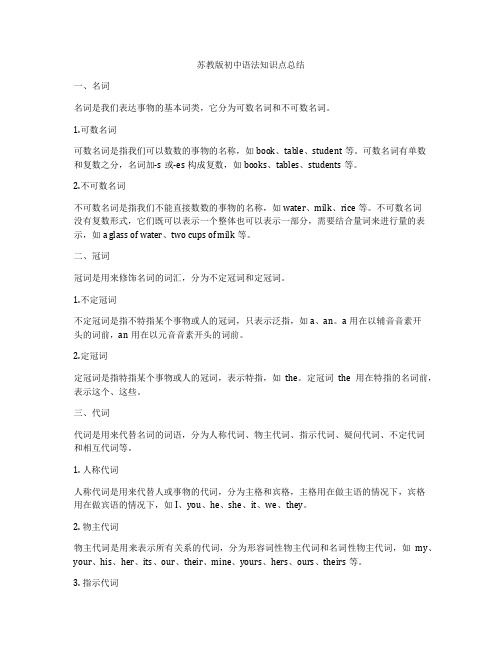
苏教版初中语法知识点总结一、名词名词是我们表达事物的基本词类,它分为可数名词和不可数名词。
1.可数名词可数名词是指我们可以数数的事物的名称,如book、table、student等。
可数名词有单数和复数之分,名词加-s或-es构成复数,如books、tables、students等。
2.不可数名词不可数名词是指我们不能直接数数的事物的名称,如water、milk、rice等。
不可数名词没有复数形式,它们既可以表示一个整体也可以表示一部分,需要结合量词来进行量的表示,如a glass of water、two cups of milk等。
二、冠词冠词是用来修饰名词的词汇,分为不定冠词和定冠词。
1.不定冠词不定冠词是指不特指某个事物或人的冠词,只表示泛指,如a、an。
a用在以辅音音素开头的词前,an用在以元音音素开头的词前。
2.定冠词定冠词是指特指某个事物或人的冠词,表示特指,如the。
定冠词the用在特指的名词前,表示这个、这些。
三、代词代词是用来代替名词的词语,分为人称代词、物主代词、指示代词、疑问代词、不定代词和相互代词等。
1. 人称代词人称代词是用来代替人或事物的代词,分为主格和宾格,主格用在做主语的情况下,宾格用在做宾语的情况下,如I、you、he、she、it、we、they。
2. 物主代词物主代词是用来表示所有关系的代词,分为形容词性物主代词和名词性物主代词,如my、your、his、her、its、our、their、mine、yours、hers、ours、theirs等。
3. 指示代词指示代词是用来指示特定事物或人的代词,分为近指示和远指示,如this、that、these、those等。
4. 疑问代词疑问代词是用来提问的代词,通常用来引导疑问句,如what、which、who、whom、whose等。
5. 不定代词不定代词是用来代替不特指、不确定的事物或人的代词,如some、any、no、every、none、few、several等。
初中语法知识点总结苏教版

初中语法知识点总结苏教版语法是语言的骨架,是语言运用规则的总称。
在初中阶段,学习语法知识是非常重要的,它可以帮助学生正确理解和使用语言,提高语言表达和文字撰写的能力。
下面就对初中语法知识点进行总结。
一、名词名词是表示人、事物、地点或抽象概念的词。
名词包括专有名词和普通名词。
1. 名词的数名词的数有单数和复数之分。
一般情况下,名词变为复数的形式有以下几种情况:在词尾加-s;以-ch, -sh, -x, -o结尾的名词加-es;以辅音字母+y结尾的名词变y为i再加-es。
2. 不可数名词不可数名词指的是不能用复数形式表示的名词,它们是无法计算的名词。
如:water, milk, rice等。
3. 名词所有格名词所有格表示属主关系,一般在名词后加-apostrophe+s。
特殊情况下,当名词尾音为-s 或-es时,只需加-apostrophe。
二、代词代词是用来代替名词的词语。
代词主要包括人称代词、物主代词、指示代词、疑问代词、不定代词等。
1. 人称代词人称代词根据不同的人称和数变化而有不同的形式。
如:I, you, he, she, it, we, they等。
2. 物主代词物主代词表示所有关系,分为形容词性物主代词和名词性物主代词。
如:my/mine,your/yours, his, her/hers, its, our/ours, their/theirs等。
3. 指示代词指示代词用于指示特定的人或事物,分为近指和远指。
如:this, that, these, those等。
4. 疑问代词疑问代词用来提问或表示疑问的代词。
如:what, which, who, whom, whose等。
5. 不定代词不定代词多用来代替不确定的人或事物,并且没有明确的数的形式。
如:some, any, one, none, either, neither, each, every等。
三、形容词形容词是用来修饰名词的词语,表示名词的性质、特征或状态。
苏教版七年级英语下册重点短语和语法总结(最新精品)
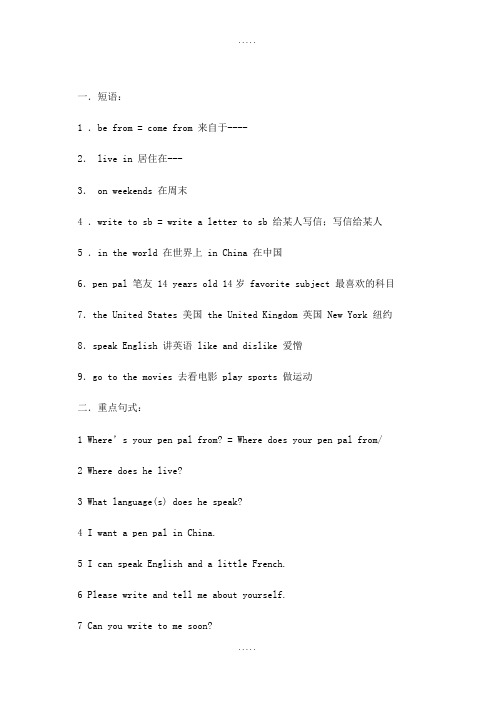
一.短语:1 .be from = come from 来自于----2. live in 居住在---3. on weekends 在周末4 .write to sb = write a letter to sb 给某人写信;写信给某人5 .in the world 在世界上 in China 在中国6.pen pal 笔友 14 years old 14岁 favorite subject 最喜欢的科目7.the United States 美国 the United Kingdom 英国 New York 纽约8.speak English 讲英语 like and dislike 爱憎9.go to the movies 去看电影 play sports 做运动二.重点句式:1 Where’s your pen pal from? = Where does your pen pal from/2 Where does he live?3 What language(s) does he speak?4 I want a pen pal in China.5 I can speak English and a little French.6 Please write and tell me about yourself.7 Can you write to me soon?8 I like going to the movies with my friends and playing sports. 三.本单元的国家,人民、语言对应。
1 Canada---- Canadian---- English / French2 France------ French------French3 Japan------Japanese----Japanese4 Australia----Australian----- English5 the United States------ American---- English6 the United Kingdom---British----- EnghishUnit 2 Where’s the post office?一. Asking ways: (问路)1.Where is (the nearest) ……?(最近的)……在哪里?2.Can you tell me the way to ……?你能告诉我去……的路吗?3.How can I get to ……?我怎样到达……呢?4.Is there …… near here / in the neighborhood? 附近有……吗?5. Which is the wa y to ……?哪条是去……的路?二.Showing the ways: (指路)1. Go straight down / along this street. 沿着这条街一直走。
苏教版初中英语知识点

苏教版初中英语知识点1. 语法知识点1.1 时态•一般现在时:表述经常、频率或客观事实•现在进行时:表示目前正在进行的动作•一般过去时:过去发生的动作或存在的状态•过去进行时:过去某一点或某一段时间内正在进行的动作•将来时:表示将来发生或存在的动作或状态1.2 语气•虚拟语气:表示假设、怀疑、建议、要求等,常用形式有虚拟条件句和虚拟感叹句•祈使句:表示命令、请求、建议等1.3 句型•肯定句:陈述一个事实或提供一个肯定的回答•否定句:否定一个事实或给出否定的回答•疑问句:询问信息,包括一般疑问句和特殊疑问句•感叹句:表达惊讶、喜悦、失望等强烈的感情2. 词汇知识点2.1 同义词•常见动词:run - jog, walk - stroll, eat - consume•常见形容词:big - large, small - tiny, happy - joyful •常见名词:car - vehicle, house - home, dog - canine 2.2 反义词•常见动词:buy - sell, give - take, come - go•常见形容词:hot - cold, tall - short, fast - slow•常见名词:day - night, left - right, beginning - end2.3 近义词•常见动词:start - begin, help - assist, finish - complete•常见形容词:happy - glad, angry - mad, tired - exhausted•常见名词:child - kid, friend - pal, parent - adult3. 阅读理解知识点3.1 主旨大意在阅读一篇文章时,理解文章的主旨对于把握文章的内容非常重要。
要注意文章的标题、首段和尾段,从中得出文章的主题。
3.2 推断和判断有时文章并没有明确给出某种信息,需要读者通过对文章的推断和判断来获取。
七年级英语苏教知识点归纳

七年级英语苏教知识点归纳近年来,随着国家教育改革的不断深入,英语教学成为了教育改革中的重点之一。
而苏教版则是国内最为知名、最受欢迎的英语教材之一。
本文将对七年级苏教英语课程中的知识点进行归纳总结,以帮助学习者更好的掌握英语知识。
一、语法知识1. 动词分类七年级苏教英语课程中常用的动词有三类,分别是实义动词、系动词和助动词。
2. 时态七年级英语教材中涉及到的时态有一般现在时、一般过去时和一般将来时三种。
其中,一般现在时用于表达现阶段的某种状态或习惯动作;一般过去时用于表达过去的某个时间节点上发生的事情或状态;一般将来时则用于表达未来某个时间内可能发生的事情。
3. 代词代词通常用于代替某个名词,帮助我们避免重复、简化语言表达。
七年级英语课程中常见的代词有人称代词、指示代词、不定代词等。
4. 形容词和副词形容词和副词可以帮助我们形容人、事、物等。
其中形容词一般用于修饰名词,而副词则用于修饰动词、形容词或其他副词。
二、听力1. 听力基础技能初学者需要掌握好听力技能,包括听力的速度、准确度、听懂出题人的意图等,尤其对于习惯中文思维的学习者,需要进行重点训练。
2. 听力训练英语听力需要大量的练习才能提高。
七年级英语教材中的听力训练包括短对话、长对话、短文和讲座等多种形式,学习者应该注重细节把握和听力技巧的实践。
三、口语1. 口语难点学习者在口语方面常见的问题是语音发音不准确、缺乏表达流利度、缺乏说英语的自信等,需要通过日常口语训练,加强基本语音、词汇和语法知识的积累。
2. 口语训练七年级英语听力课程中常用的口语训练包括问答、短演讲等。
学习者应该多做口语训练,让自己的口语技能得到全方位的提升。
四、阅读1. 阅读理解阅读理解是英语学习内容的重要组成部分。
七年级英语教材中,阅读材料涉及到各种日常生活事例、科学知识等,需要学习者通过阅读,获得并理解材料中的内容。
2. 阅读策略学习者需要运用一些阅读技巧和策略,帮助自己更快、更准确地理解阅读材料。
苏教版译林牛津初中英语语法总结(初一初二)

苏教版译林牛津初中英语语法总结(初一初二)补充:1.句子的构成初中一年级上语法1.in,on,at表示时间的应用in +parts of day(evening,morning,etc) /month/season/year on + day (Sunday, etc)/date(1 July,etc)/parts of a special day( Sunday morning)/special holidays(Children’s Day) at + time of day (seven o’clock)/ age(6 years old)2.频率副词never, seldom,sometimes,often,usually,always3.疑问副词的用法what,which,who,whose,when,why,how4.可数名词与不可数名词5.some和any的用法6.There be句型7.现在进行时及动词+ing的用法初中一年级下语法1.序数词与基数词2.一般将来时:will与shall、be going to3.名词所有格名字+’s,mine,yours,ours,theirs,his,hers,its4.冠词a,an, the的用法5.表示方位的介词In front of, behind,inside,outside,above,below,over,under6.一般过去式及过去分词+ed的用法7.can,could,may的用法8.What 和How开头的感叹句9形容词的用法,在句子中的位置10.不定代词的用法Somebody, someone, somethingAnybody, anyone, anythingNobody, no one, nothingEverybody, everyone, everthing初中二年级上语法1.比较级、最高级的用法than作为比较级、the+最高级的用法+er 及+est 的用法,most+形容词表示最高级2. more…than, fewer….than,less..than, the most, the fewest, the least的用法3. as…as的用法4.反身代词的用法Myself, yourself, himself, herself, itself, ourselves, yourselves, themselves5.祈使句的用法肯定:Open the door.否定:Don’t close the window.礼貌些:Please….6.表示建议should和had better的用法7.may来表示可能性的用法(区别初一下7,may作为询问语气的用法)8.不定式用法9.用不定式表示目的,用in order to表示目的10. A.“动词+宾语+不定式”结构,即,动词+宾语+to do(不定式)可用这类结构的常用动词有advise, allow, ask, bear, beg, bother, cause, command, determine, encourage, expect, forbid, force, get, hate, help, intend, invite, leave, like, mean, need, order, permit, persuade, prefer, request, remind, request, teach, tell,trouble, want, warn, wish等。
- 1、下载文档前请自行甄别文档内容的完整性,平台不提供额外的编辑、内容补充、找答案等附加服务。
- 2、"仅部分预览"的文档,不可在线预览部分如存在完整性等问题,可反馈申请退款(可完整预览的文档不适用该条件!)。
- 3、如文档侵犯您的权益,请联系客服反馈,我们会尽快为您处理(人工客服工作时间:9:00-18:30)。
的区别和“for”现在完成时中“since”1)since +过去一个时间点(如具体的年、月、日期、钟点、1980,last month,half past six)。
I have been here since 1989.2)since +一段时间+ agoI have been here since five months ago.3)since +从句Great changes have taken place since you left.Considerable time has elapsed since we have been here.4)It is +一段时间+ since从句It is two years since I became a postgraduate student.Since 用来说明动作起始时间,for用来说明动作延续时间长度。
I have lived here for more than twenty years.I have lived here since I was born..My aunt has worked in a clinic since 1949.Some new oilfields have been opened up since 1976.I have known Xiao Li since she was a little girl.My brother has been in the Youth League for two years.I have not heard from my uncle for a long time.注意:并非有for 作为时间状语的句子都用现在完成时。
I worked here for more than twenty years.(我现在已不在这里工作。
)I have worked here for many years.(现在我仍在这里工作。
)小窍门:当现在完成时+一段时间,这一结构中,我们用下面的公式转化,很容易就能排除非延续动词在完成时中的误使。
1)(对)Tom has studied Russian for three years.= Tom began to study Russian three years ago,and is still studying it now.2)(错)Harry has got married for six years.= Harry began to get married six years ago,and is still getting married now.显然,第二句不对,它应改为Harry got married six years ago.或Harry has been married for six years.声音:sound,noise 与voice的区别sound表示听起来像……和like连用,如:It`s sounds like a bird.听起来像鸟在叫。
voice表示嗓音,说他的嗓音很动听,用his voice was good.noise是杂音,响动的意思。
如:我听到有动静。
I heard a noise .这是一组与“声音”有关的名词,在使用上有区别。
sound泛指自然界各种各样的声音,不论其高低、是否悦耳等。
如:I heard the sound of running water. 我听见流水声。
Light travels faster than sound. 光比声音传播得快。
noise表示“噪音、喧闹”,指的是人们不愿听到的声音或嘈杂声。
它可以作可数名词,也可以用作不可数名词。
如:I heard some strange noises last night. 昨夜我听见一些奇怪的响声。
There's a lot of noise here. 这个地方人声嘈杂。
voice用于人时,指说话、歌唱或发笑的声音,也可指发言权。
用于其它方面时,常含悦耳之声,如鸟鸣声,乐器声音等。
如:Please speak in a louder voice. 请大声说。
说:tell,speak,say,talk的区别tell 意为“告诉、讲述”,指某人把某一件事、一条信息传送给别人或讲述一件事。
tell sb sth 意为“告知某人某事”。
tell sb to do sth 意为“告诉某人去做某事”。
speak 意为“说话、讲话”,后面主要接语言。
speak to 意为“和.....讲话、谈话”。
speak of 意为“提到、说起”。
speak to sb about sthtalk 意为“谈话、讲话”,如果只有一方对另一方说话时,一般用talk to;如果双方或多。
have a talk with 意为“与......交谈”。
方交谈,多用with。
talk about 意为“谈论......”say 意为“说”。
say sth to sb 意为“对......说”。
It is said that... 意为“据说”。
首先是say:之后要有说的内容,如He said nothing.▲ say一般作及物动词用,着重说话的内容,它的宾语可以是名词,代词或宾语从句。
eg: He can say his name. 他会说他的名字。
Please say it in English. 请用英语用。
She`s saying ,Don`t draw on the wall.她在说“别在墙上画”。
▲ speak强调说的动作,不强调所说的内容。
作及物动词时,常以某种语言作宾语。
作不及物动词时,常见的搭配形式有:speak of something/somebody谈到某事(某人)speak to sb 跟某人讲话,此外speak还可用于在较为正式的场合了表演讲或演说。
Can you speak Japanese? 你会说日语吗?She is speaking to her teacher. 她正在跟她的老师说话。
He spoke at the meeting yesterday. 他昨天在会上讲了话。
▲ talk 一般为不及物动词,意思是“交谈,谈话,着重强调两具之间的相互说话。
eg: She is talking with Lucy in English.她正在和露茜用英语交谈。
What are you talking about? 你们在谈论什么?The teacher is talking to him. 老师正在和他谈话。
▲ tell常作及物动词,意为“讲述,告诉,动词常跟双宾语。
tell sb sth=tell sth to sb告诉某人某事。
eg: He is telling the children a story.他正在给孩子们讲一个故事。
Did you tell her the news?=Did you tell the news to her?你把这个消息告诉她了吗?used to 与be used to(1)used to + do:"过去常常"表示过去习惯性的动作或状态,但如今已不存在。
Mother used not to be so forgetful.Scarf used to take a walk. (过去常常散步)(2)be used to + doing:对……已感到习惯,或"习惯于",to是介词,后需加名词或动名词。
He is used to a vegetarian diet.Scarf is used to taking a walk.(现在习惯于散步)将要:be to和be going tobe to 表示客观安排或受人指示而做某事。
be going to 表示主观的打算或计划。
I am to play football tomorrow afternoon. (客观安排)I'm going to play football tomorrow afternoon. (主观安排)twice、two times关于 A runs twice faster than B 这个的翻译,现在都还存在争议。
有的人认为是A的速度是B的2倍,有人认为是A比B快2倍=A是B的3倍。
表示A是B的N倍。
“A + be + 倍数+ as + 计量形容词原级+ as + B”1.This tree is three times as tall as that one.这棵树是那棵树的三倍高。
2.His father is twice as old as he.他父亲的年纪有他两倍大。
两倍用twice,不用two times.注意:两倍一般都用twice,不用two times例如:This tree is twice higher than that one.=This tree is twice as high as that one.=This tree is twice the height of that one.倍数+比较级+ than ...= 倍数+ as + 形容词原形+as ...= 倍数+the +形容词所对应的名词+ of ...other、another、others、the other(1)other后既可接可数名词复数形式又可接不可数名词,如:可数,other pencils 其它的铅笔,other students 其他的学生。
不可数other tea 别的/其它的茶,other information 别的/其它消息。
any other其他一切的什么……(2)the other 定指其它的……,其后可接可数名词和单数,如:the other book 另外的一本书,the other map 另一张地图,其后也可跟可数名词的复数形式,如:the other flowers 其他的花朵,the other teachers 其它的老师们,还可以接不可数名词,如:the other water 剩下的水,the other beer 别的啤酒other 表“另外的”接复数名词,如与具体数词连用,则置于数词之后,如:two other boys;但与定冠词the连用时,other要放在数词前。
如:the other two boysTony is going camping with _C__boys next Sunday.托尼将于下周日与另外两个男孩一起去野营。
A.little two other B.two little otherC.two other little D.little other twoMr Smith asked me to fetch three other recorders.史密斯先生让我再拿三台录音机来。
